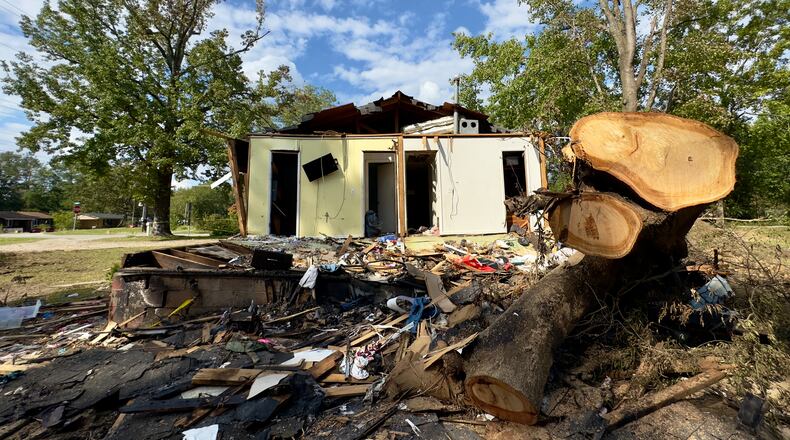At least 33 Georgians have died as a result of Hurricane Helene and nearly 300,000 customers remained without power Thursday, Gov. Brian Kemp said.
Cleanup after the catastrophic storm has been ongoing since it raged across the Southeast last week, leaving a trail of darkness in its wake. The overall death toll has risen to 200, the Associated Press reported.
In Georgia, three deaths were associated with carbon monoxide poisoning from a generator in Chatham County, Kemp said.
“Make sure that your generator’s placed a safe distance from your home or your shop or wherever it is that you’re staying to make sure that we do not have any more fatalities from generator episodes,” the governor said.
Power crews have been working around the clock to restore service to customers across the state. While 300,000 are still without power, that is down from the roughly 1.3 million outages immediately following the storm.
Georgia Department of Transportation crews have also worked feverishly to reopen hundreds of blocked roads, including state routes and at least three interstates, Commissioner Russell McMurry said. At its peak, more than 300 roads were impassable, adding up to about 60,000 miles of road being impacted.
“This storm was so big ... we’ve had right at 2,000 employees at one time working in all 159 counties,” McMurry said. “Since then, we’ve triaged to work in the counties most affected, from Valdosta all the way to Augusta.”
Now that he’s had time to assess the state’s response, Kemp said there’s not a whole lot he thinks they could have done differently. He said he’d like to review how the state could be more efficient in helping local governments, but the biggest takeaway, he said, is for everyone to prepare for the worst. The rule of thumb is to have enough supplies to last 72 hours.
”I think a lot of people got blindsided,” he said. “It’s a good lesson for all of us.”
It’s not just the state providing relief. Aid from neighboring jurisdictions and hundreds of volunteers from less-impacted areas and other states have poured in.
DeKalb County, for example, is sending 5,000 boxes of food and emergency supplies to Augusta.
County CEO Michael Thurmond said they are “honored to support … our neighbors in Augusta who are struggling to recover from the devastation wrought by Hurricane Helene.”
The convoy will travel to Augusta on Friday. The boxes will contain Georgia-grown fruits, vegetables and produce that can be consumed without cooking, sanitizers, masks and COVID-19 tests.
“We are grateful to DeKalb County which has, by their words and deeds, demonstrated that they are our good neighbors,” Augusta Mayor Garnett Johnson said. “DeKalb’s generosity will never be forgotten.”
The boxes will be distributed at the following locations in Augusta:
• Good Shepherd Baptist, 1714 Olive Road
• Broadway Baptist, 2323 Barton Chapel Road
• Everfaithful Baptist Church, 314 Sand Bar Ferry Road
• Faith Outreach Church, 102 South Belair Road
Additionally, the Augusta National Golf Club, in partnership with the Community Foundation for the CSRA, is donating $5 million toward the Hurricane Helene Community Crisis Fund, which will support local relief efforts in response to the devastating impact of the storm throughout the greater Augusta community.
Storm damage is also still affecting schools. Ware County, for example, will be closed through Oct. 18.
BY THE NUMBERS
1.3 million people were without power at its peak.
8,000 Georgia Power poles need to be replaced. The utility company’s previous record from a storm was 1,700 polls.
21,000 spans of power wires are on the ground, which equals about 1,000 miles of wire that must be put back up or replaced.
3,200 trees fell on power lines across the state, including some over swamps that can only be removed by helicopter.
300 state routes were blocked by fallen trees and other debris, including three interstates.
32,000 miles of roads were impacted by the storm in the 41 counties that were included in the federal disaster declaration — double that if you include all 90 counties that state officials say were hit by the storm.
106 traffic signals need replacing.
146 traffic signals don’t have power.
2,600 traffic signs have been replaced, and thousands more are missing. Officials have been replacing the “red” signs first, including signs telling drivers to stop, yield or that they are traveling in the wrong direction.
$417 million estimated damages. But state officials say that number will go way up.
— Adam Beam
About the Author
Keep Reading
The Latest
Featured


